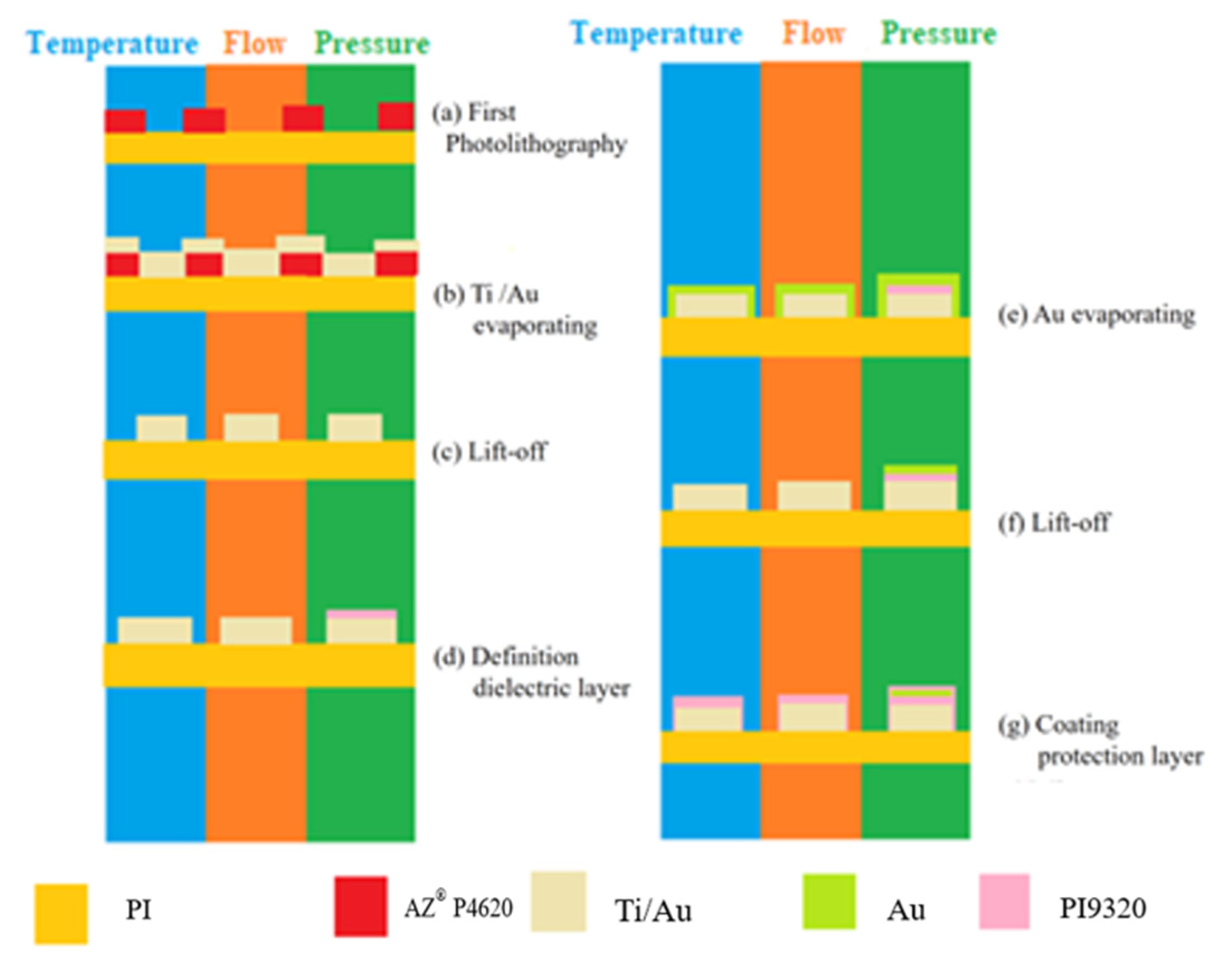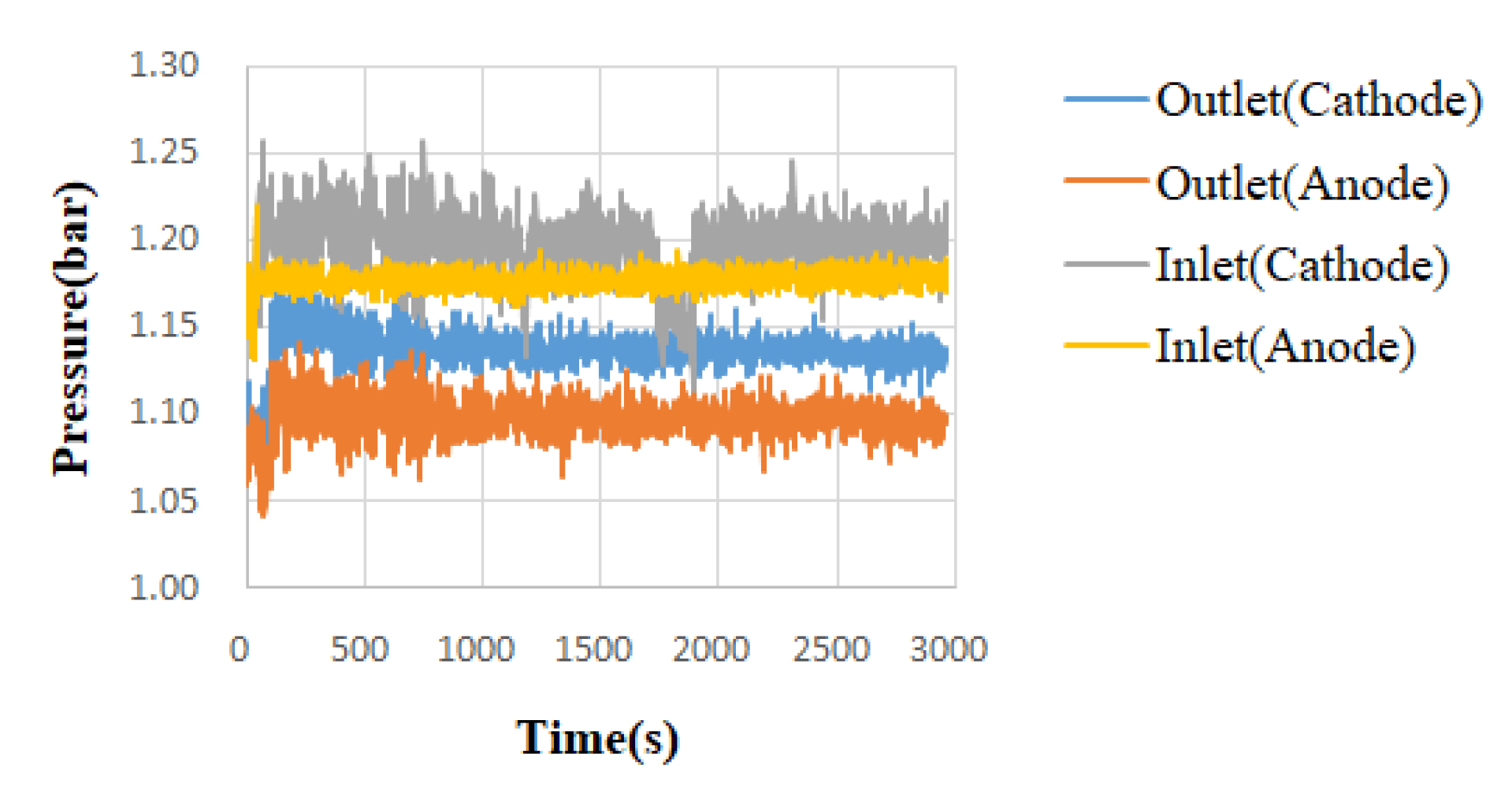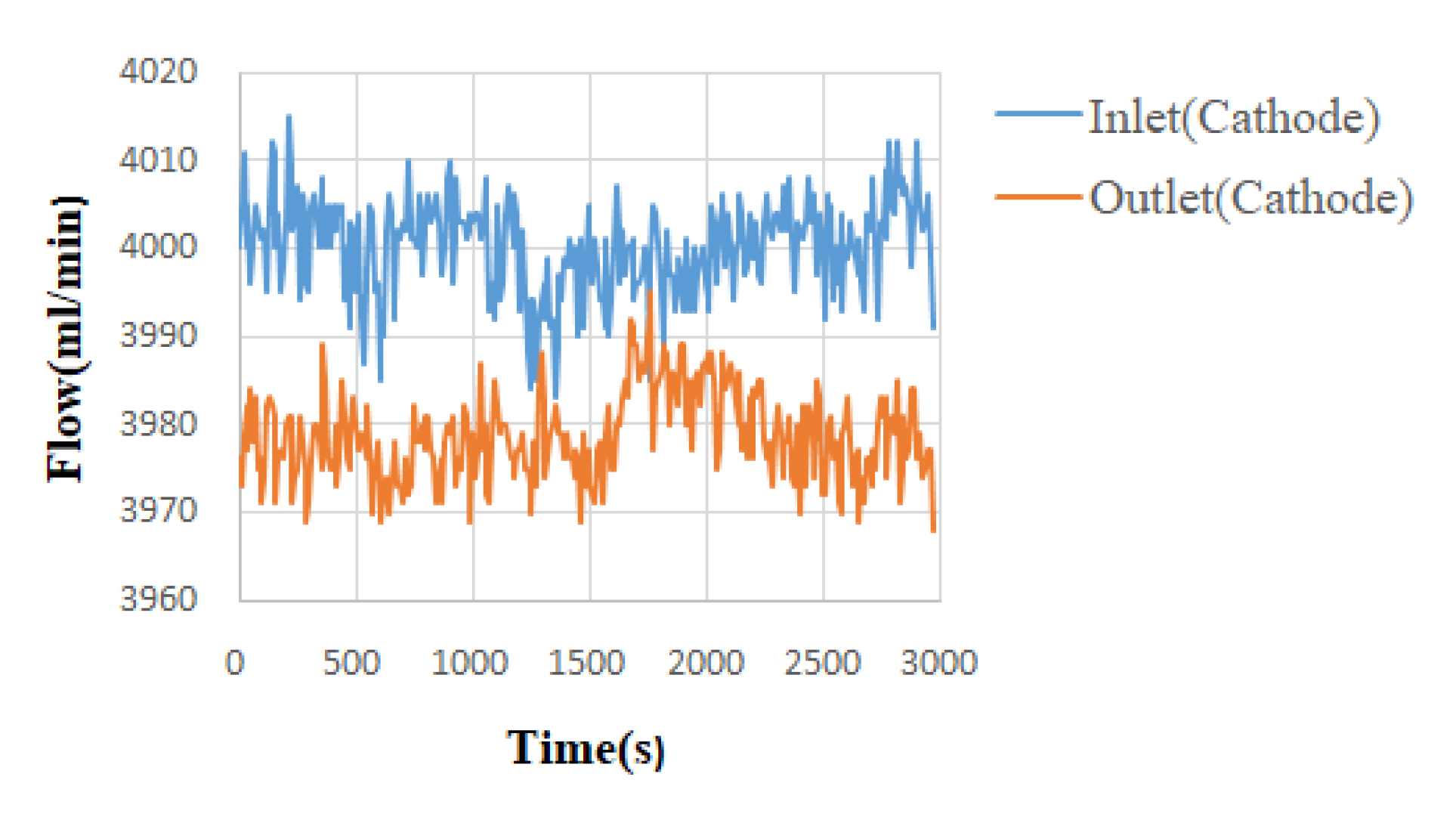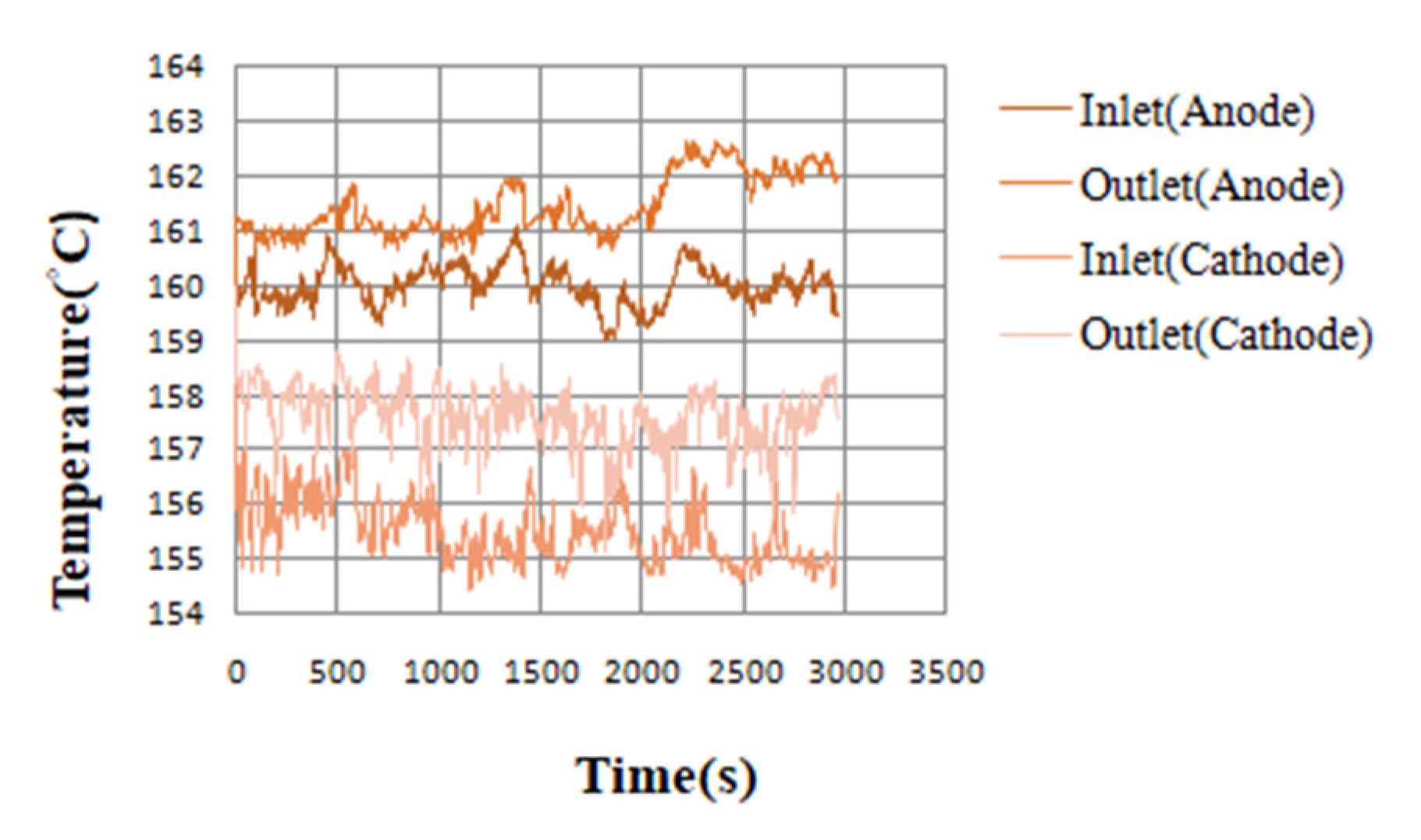Real-Time Monitoring of the Temperature, Flow, and Pressure Inside High-Temperature Proton Exchange Membrane Fuel Cells
Abstract
:1. Introduction
2. Process of Three-in-One Flexible Micro-Sensors
3. Real-Time Micro-Monitoring of the Three-in-One Flexible Micro-Sensor Embedded in a High-Temperature PEMFC
4. Conclusions
Author Contributions
Funding
Acknowledgments
Conflicts of Interest
References
- Wong, C.Y.; Wong, W.Y.; Ramya, K.; Khalid, M.; Loh, K.S.; Daud, W.R.W.; Lim, K.L.; Walvekar, R.; Kadhum, A.A.H. Additives in proton exchange membranes for low- and high-temperature fuel cell applications: A review. Int. J. Hydrogen Energy 2019, 44, 6116–6135. [Google Scholar] [CrossRef]
- Wang, P.; Liu, Z.; Li, X.; Peng, J.; Hu, W.; Liu, B. Toward enhanced conductivity of high-temperature proton exchange membranes: Development of novel PIM-1 reinforced PBI alloy membranes. Chem. Commun. 2019, 55, 6491–6494. [Google Scholar] [CrossRef] [PubMed]
- Liu, J.; Li, Q.; Chen, W.; Yan, Y.; Wang, X. A fast fault diagnosis method of the PEMFC system based on extreme learning machine and Dempster-Shafer evidence theory. IEEE Trans. Transp. Electrif. 2019, 5, 271–284. [Google Scholar] [CrossRef]
- Hussain, F.; Abbas, G.; Ahmad, M.A.; Raza, R.; Rehman, Z.U.; Mumtaz, S.; Akbar, M.; Riaz, R.A.; Dilshad, S. Comparative electrochemical investigation of zinc based nano-composite anode materials for solid oxide fuel cell. Ceram. Int. 2019, 45, 1077–1083. [Google Scholar] [CrossRef]
- Bai, H.; Peng, H.; Xiang, Y.; Zhang, J.; Wang, H.; Lu, S.; Zhuang, L. Poly(arylene piperidine)s with phosphoric acid doping as high temperature polymer electrolyte membrane for durable, high-performance fuel cells. J. Power Sources 2019, 443, 227219–227227. [Google Scholar] [CrossRef]
- Gao, H.; Wang, Z.; Yin, S.; Lu, J.; Guo, Z.; Ma, W. Adaptive real-time optimal energy management strategy based on equivalent factors optimization for hybrid fuel cell system. Int. J. Hydrogen Energy 2021, 46, 4329–4338. [Google Scholar] [CrossRef]
- Guo, Z.; Chen, J.; Byun, J.J.; Perez–Page, M.; Ji, Z.; Zhao, Z.; Holmes, S.M. Insights into the performance and degradation of polybenzimidazole/muscovite composite membranes in high–temperature proton exchange membrane fuel cells. J. Membr. Sci. 2022, 641, 119868–119882. [Google Scholar] [CrossRef]
- Nam, L.V.; Choi, E.; Jang, S.; Kim, S.M. Patterned mesoporous TiO2 microplates embedded in Nafion® membrane for high temperature/low relative humidity polymer electrolyte membrane fuel cell operation. Renew. Energy 2021, 180, 203–212. [Google Scholar] [CrossRef]
- Askaripour, H. Effect of operating conditions on the performance of a PEM fuel cell. Int. J. Heat Mass Transf. 2019, 144, 118705–118714. [Google Scholar] [CrossRef]
- Liu, S.; Chen, T.; Zhang, C.; Xie, Y. Study on the performance of proton exchange membrane fuel cell (PEMFC) with dead-ended anode in gravity environment. Appl. Energy 2020, 261, 114454–114466. [Google Scholar] [CrossRef]
- Yang, K.; Yang, Q.; Zhu, X.; Wang, H.; Zhu, T.; Liu, J. A molecular dynamics simulation on the static calibration test of a revised thin-film thermopile heat-flux sensor. Measurement 2020, 150, 107039–107048. [Google Scholar] [CrossRef]
- Sun, Z.; Shen, Y.; Yuan, C.; Li, X. Influence of contamination on measurement accuracy of the calorimetric air flow sensor. Measurement 2019, 145, 108–117. [Google Scholar] [CrossRef]
- Barnoon, P.; Toghraie, D.; Mehmandoust, B.; Fazilati, M.A.; Eftekhari, S.A. Natural-forced cooling and Monte-Carlo multi-objective optimization of mechanical and thermal characteristics of a bipolar plate for use in a proton exchange membrane fuel cell. Energy Rep. 2022, 8, 2747–2761. [Google Scholar] [CrossRef]
- Peng, Y.; Mahyari, H.M.; Moshfegh, A.; Javadzadegan, A.; Toghraie, D.; Shams, M.; Rostami, S. A transient heat and mass transfer CFD simulation for proton exchange membrane fuel cells (PEMFC) with a dead-ended anode channel. Int. Commun. Heat Mass Transf. 2020, 115, 104638–104648. [Google Scholar] [CrossRef]
- Hosseini, M.; Afrouzi, H.H.; Arasteh, H.; Toghraie, D. Energy analysis of a proton exchange membrane fuel cell (PEMFC) with an open-ended anode using agglomerate model: A CFD study. Energy 2019, 188, 116090–116103. [Google Scholar] [CrossRef]
- Taccani, R.; Zuliani, N. Effect of flow field design on performances of high temperature PEM fuel cells: Experimental analysis. Int. J. Hydrogen Energy 2011, 36, 10282–10287. [Google Scholar] [CrossRef]
- Lobato, J.; Cañizares, P.; Rodrigo, M.A.; Pinar, F.J.; Mena, E.; Úbeda, D. Three-dimensional model of a 50 cm2 high temperature PEM fuel cell. Study of the flow channel geometry influence. Int. J. Hydrogen Energy 2010, 35, 5510–5520. [Google Scholar] [CrossRef]
- Jo, A.; Oh, K.; Lee, J.; Han, D.; Kim, D.; Kim, J.; Kim, B.; Kim, J.; Park, D.; Kim, M.; et al. Modeling and analysis of a 5 kWe HT-PEMFC system for residential heat and power generation. Int. J. Hydrogen Energy 2017, 42, 1698–1714. [Google Scholar] [CrossRef]
- Thomas, S.; Bates, A.; Park, S.; Sahu, A.K.; Lee, S.C.; Son, B.R.; Kim, J.G.; Lee, D.H. An experimental and simulation study of novel channel designs for open-cathode high-temperature polymer electrolyte membrane fuel cells. Appl. Energy 2016, 165, 765–776. [Google Scholar] [CrossRef]
- Wu, H.; Kang, D.; Perng, S. Effect of rectangular ribs in the flow channels of HTPEM fuel cell by a three-dimensional model. Energy Procedia 2017, 105, 1376–1381. [Google Scholar] [CrossRef]






| Item | Condition |
|---|---|
| Cell temperature (°C) | 160 |
| Anode flow (H2) (lspm) | 2 |
| Cathode flow (Air) (lspm) | 4 |
| Gas temperature | Room temperature |
| Constant current (A/cm2) | 0.8 |
| Reaction area (cm2) | 31.4 |
Publisher’s Note: MDPI stays neutral with regard to jurisdictional claims in published maps and institutional affiliations. |
© 2022 by the authors. Licensee MDPI, Basel, Switzerland. This article is an open access article distributed under the terms and conditions of the Creative Commons Attribution (CC BY) license (https://creativecommons.org/licenses/by/4.0/).
Share and Cite
Lee, C.-Y.; Weng, F.-B.; Chiu, C.-W.; Nawale, S.-M.; Lai, B.-J. Real-Time Monitoring of the Temperature, Flow, and Pressure Inside High-Temperature Proton Exchange Membrane Fuel Cells. Micromachines 2022, 13, 1040. https://doi.org/10.3390/mi13071040
Lee C-Y, Weng F-B, Chiu C-W, Nawale S-M, Lai B-J. Real-Time Monitoring of the Temperature, Flow, and Pressure Inside High-Temperature Proton Exchange Membrane Fuel Cells. Micromachines. 2022; 13(7):1040. https://doi.org/10.3390/mi13071040
Chicago/Turabian StyleLee, Chi-Yuan, Fang-Bor Weng, Chun-Wei Chiu, Shubham-Manoj Nawale, and Bo-Jui Lai. 2022. "Real-Time Monitoring of the Temperature, Flow, and Pressure Inside High-Temperature Proton Exchange Membrane Fuel Cells" Micromachines 13, no. 7: 1040. https://doi.org/10.3390/mi13071040
APA StyleLee, C.-Y., Weng, F.-B., Chiu, C.-W., Nawale, S.-M., & Lai, B.-J. (2022). Real-Time Monitoring of the Temperature, Flow, and Pressure Inside High-Temperature Proton Exchange Membrane Fuel Cells. Micromachines, 13(7), 1040. https://doi.org/10.3390/mi13071040







